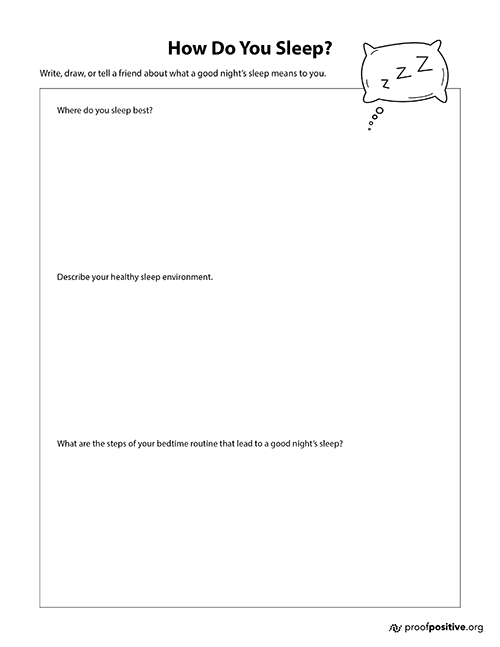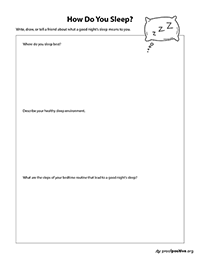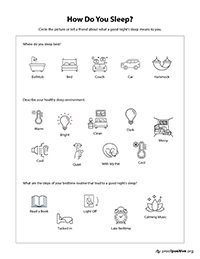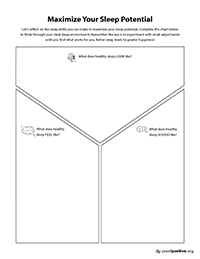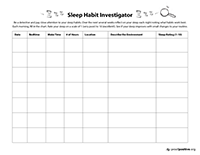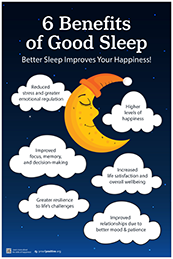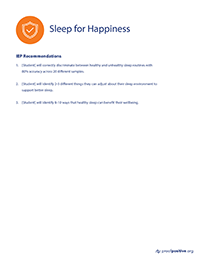TEACH Sleep for Happiness
Explore the intersection of positive psychology and autism intervention by teaching your students how to optimize their sleep to maximize happiness.
Start Teaching!
This comprehensive bundle comes with everything you need to bring Sleep for Happiness into the classroom, from teaching slides and notes to supplementary resources.
Quick Link Library
5 Minutes
5 Minutes
10 Minutes
Maximize Your Sleep Potential Modified
5 Minutes
5 Minutes per Day
10 Minutes
Behavioral Intervention Plan Recommendations
15 Minutes
15 Minutes
Integration Into Curriculum Instruction
15 Minutes
Expanded Teaching Resources
Lesson Plans & Teaching Materials
- Objectives (PDF)
- Teaching Slides — All Activities (Google Slides)
- Teacher’s Guide (Google Slides, PDF)
- Teacher Answer Key (PDF)
- Unit Study Bundle Pack — All Activities (PDF)
Behavior Intervention Plans (BIPs) are more than just behavior supports – they’re pathways to learning and success. By prioritizing wellbeing and happiness in BIPs, you can help create structure and consistency while also making space for joy, connection and resilience. With the right supports in place, students can feel empowered, successful and experience more happiness at school.
- Set timers or alarms at night to begin calming activities (e.g., listening to quiet music, reading or listening to a story, and/or relaxation exercises) instead of stimulating behaviors (e.g., watching TV and/or playing games) before bed. Consider providing a choice board of calming activities that the individual can choose from each night.
- Provide access to breaks throughout the school day (this could be a visual choice board or series of alarms /reminders on digital devices) that are centered around creating healthy sleep habits (e.g. movement, meditation, relaxation exercises, listening to quiet music, etc.). Daytime sleep shifts are just as important as nighttime sleep shifts!
- Provide a structured bedtime routine or checklist (e.g., brushing teeth, putting on pajamas, and/or reading, listening to calm music, and relaxation exercises) that the student can follow on a nightly basis. The checklist could be a physical checklist, activity schedule on a device, task analysis, etc.
- If a caregiver reports that a student had minimal sleep the night before (less than 6 hours), consider offering the opportunity for a short nap. This will be offered as a proactive strategy to reduce challenging behaviors that are often correlated with poor sleep the previous night.
Individualized Education Plans (IEPs) ensure every student has access to the supports they need to thrive. When happiness and wellbeing is included and prioritized in IEPs, students are more likely to flourish in learning and in life. By shifting from a deficit-based approach to one of strengths and potential, IEPs can open doors to learning, connection and joy – at school and beyond.
- [Student] will correctly discriminate between healthy and unhealthy sleep routines with 80% accuracy across 20 different samples.
- [Student] will identify 2-3 different things they can adjust about their sleep environment to support better sleep.
- [Student] will identify 8-10 ways that healthy sleep can benefit their wellbeing.
Bringing wellbeing to the forefront doesn’t require a complete overhaul of your classroom routine. By integrating happiness skills into what you’re already teaching, you can help students learn and practice happiness in simple, meaningful ways. From morning meetings and check-ins to reading, writing, and relationship-building, there are countless ways to make wellbeing part of everyday learning.
- Do students already follow a morning or bedtime routine? Use this skill to explore small tweaks that could improve sleep quality, like adjusting screen time, adding a calming activity, or setting a consistent wake-up time. Consider using visual schedules or first-then prompts to reinforce habits and routines.
- Are students learning about emotional regulation? Incorporate discussions on how sleep impacts mood, focus, and wellbeing. Have students reflect on how their energy and emotions shift with
different sleep patterns. - If your students track behaviors (like steps, moods, or habits), add sleep tracking! Have them keep a log of the amount of hours they slept, bedtime and wake time, how they feel the next day, etc. You may also consider using a visual mood/emotion meter, emoji check-ins, or color-coded sleep charts. Students can start to notice patterns between sleep and daily wellbeing and identify which sleep shifts work best for them.
- Do you already use a communication log? Consider adding a section for sleep and perhaps a prompt like, “How did you sleep last night? How do you feel this morning?”
- Just like movement or nutrition, sleep isn’t one-size-fits-all. Some students might struggle with sleep due to sensory needs, anxiety, or routines at home. Encourage students to identify small, personalized shifts that could make a difference in their sleep experience.
Classroom Activities
Each activity includes teacher notes and differentiated instruction across skill levels
- Activity 1: An Introduction to Sleep for Happiness
25 Minutes / Google Slides + Teacher Notes / Student Worksheets (PDF) - Activity 2: What is Sleep?
15 Minutes / Google Slides + Teacher Notes - Activity 3: The Sleep Happiness Connection
15 Minutes / Google Slides + Teacher Notes - Activity 4: Sleep Shifts
45-60 Minutes / Google Slides + Teacher Notes / Student Worksheets (PDF) - Unit Study Bundle Pack — All Activities (PDF)


